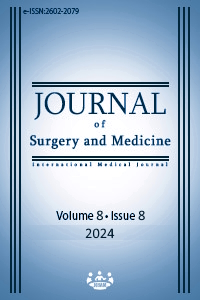Effect of cardiac rehabilitation on heart rate recovery in patients with coronary artery disease
Effect of cardiac rehabilitation on heart rate recovery
Keywords:
Coronary artery disease, cardiac rehabilitation, heart rate recoveryAbstract
Background/Aim: It is well-established that individuals with coronary artery disease (CAD) often exhibit autonomic dysfunction and a reduction in vagal function is associated with increased mortality and morbidity. Vagally mediated heart rate recovery (HRR) can be assessed by analyzing the post-exercise heart rate (HR) decay. It is hypothesized that effective exercise-based cardiac rehabilitation (CR) can enhance post-exercise parasympathetic function. This study aims to evaluate the impact of CR on HRR and other cardiac parameters in CAD patients.
Methods: This retrospective cohort study was conducted at a single center. It included patients with CAD who were referred to the CR unit and completed either 30 or 60 sessions. These patients were free from angina or angina-equivalent symptoms at the time of enrollment and were receiving guideline-directed medical therapy for ischemic heart disease. A customized CR program was implemented for each patient. To calculate HRR, the maximum HR during the exercise test and HR values at 1, 2, and 3 minutes after exercise cessation were recorded. The differences between the maximum HR and the HR values at the end of the 1st, 2nd, and 3rd minutes after exercise were designated as HRR1, HRR2, and HRR3, respectively.
Results: This study enrolled 104 patients with CAD. Following CR, there was a significant improvement in functional capacity, as assessed by the 6-minute walk test (from 367.83 [56.58] to 381.61 [53.76], P=0.001), and endurance, as measured by the Cycle Ergometer Test Maximum Watts (from 63.22 [22.29] to 77.38 [19.87], P<0.001). CR also led to a noteworthy increase in HRR1, HRR2, and HRR3 (P=0.036, P=0.015, P=0.002, respectively).
Conclusion: In our study, both the functional capacity and endurance of CAD patients improved significantly after CR sessions. Additionally, HRR showed a substantial increase following CR, suggesting that exercise-based CR can enhance post-exercise parasympathetic function. HRR may serve as a potential prognostic marker for predicting outcomes in CR.
Downloads
References
Nowbar AN, Gitto M, Howard JP, Francis DP, Al-Lamee R. Mortality from ischemic heart disease. Circ Cardiovasc Qual Outcomes. 2019;12:e005375. DOI: https://doi.org/10.1161/CIRCOUTCOMES.118.005375
Olshansky B, Sabbah HN, Hauptman PJ, Colucci WS. Parasympathetic nervous system and heart failure: pathophysiology and potential implications for therapy. Circulation. 2008;118:863-71. DOI: https://doi.org/10.1161/CIRCULATIONAHA.107.760405
Olshansky B. Vagus nerve modulation of inflammation. Cardiovascular implications. Trends in Cardiovascular Medicine. 2016;01:1-11. DOI: https://doi.org/10.1016/j.tcm.2015.03.016
Conraads VM, Pattyn N, De Maeyer C, Beckers PJ, Coeckelberghs E, Cornelissen VA et al. Aerobic interval training and continuous training equally improve aerobic exercise capacity in patients with coronary artery disease: the SAINTEX-CAD study. Int J Cardiol. 2015;179:203–10. DOI: https://doi.org/10.1016/j.ijcard.2014.10.155
Anderson L, Oldridge N, Thompson DR, Zwisler AD, Rees K, Martin N, et al. Exercise-based cardiac rehabilitation for coronary heart disease: Cochrane systematic review and metaanalysis. J Am Coll Cardiol. 2016;67:1–12. DOI: https://doi.org/10.1016/j.jacc.2015.10.044
Rocamora AM, Ribeiro F, Sarabia JM, Íbias J, Oliveira NL, Vera-García FJ, et al. Exercise-based cardiac rehabilitation and parasympathetic function in patients with coronary artery disease: a systematic review and meta-analysis. Clin Auton Res. 2021;31:187-203. doi: 10.1007/s10286-020-00687-0. DOI: https://doi.org/10.1007/s10286-020-00687-0
Kaya BB, Ozbilgin N. Effect of cardiac rehabilitation on mortality related inflammatory markers. J Surg Med. 2019;3(8):588-92. doi: 10.28982/josam.606487 DOI: https://doi.org/10.28982/josam.606487
Peçanha T, Silva-Júnior ND, Forjaz CL. Heart rate recovery: autonomic determinants, methods of assessment and association with mortality and cardiovascular diseases. Clin Physiol Funct Imag. 2014;34:327–39. DOI: https://doi.org/10.1111/cpf.12102
Cole CR, Blackstone EH, Pashkow FJ, Snader CE, Lauer MS. Heart-rate recovery immediately after exercise as a predictor of mortality. N Engl J Med. 1999;341:1351–7. DOI: https://doi.org/10.1056/NEJM199910283411804
Jose AD, Collison D. The normal range and determinants of the intrinsic heart rate in man. Cardiovasc Res. 1970;4:160-7. doi: 10.1093/cvr/4.2.160. DOI: https://doi.org/10.1093/cvr/4.2.160
Imai K, Sato H, Hori M, H Kusuoka, H Ozaki, H Yokoyama, et al. Vagally mediated heart rate recovery after exercise is accelerated in athletes but blunted in patients with chronic heart failure. J Am Coll Cardiol. 1994;15;24:1529-35. doi: 10.1016/0735-1097(94)90150-3. DOI: https://doi.org/10.1016/0735-1097(94)90150-3
Besnier F, Labrunee M, Pathak A, Pavy-Le Traon A, Galès C, Sénard JM, et al. Exercise training-induced modification in autonomic nervous system: an update for cardiac patients. Ann Phys Rehabil Med. 2017;60:27–35. doi: 10.1016/j.rehab.2016.07.002 DOI: https://doi.org/10.1016/j.rehab.2016.07.002
Thayer JF, Lane RD. The role of vagal function in the risk for cardiovascular disease and mortality. Review Biol Psychol. 2007;74:224-42. doi: 10.1016/j.biopsycho.2005.11.013. DOI: https://doi.org/10.1016/j.biopsycho.2005.11.013
Vivekananthan DP, Blackstone EH, Pothier CE, Lauer MS. Heart rate recovery after exercise is a predictor of mortality, independent of the angiographic severity of coronary disease. J Am Coll Cardiol. 2003;42:831–8. DOI: https://doi.org/10.1016/S0735-1097(03)00833-7
Nishime EO, Cole CR, Blackstone EH, Pashkow FJ, Lauer MS. Heart rate recovery and treadmill exercise score as predictors of mortality in patients referred for exercise ECG. JAMA. 2000;284:1392–8. DOI: https://doi.org/10.1001/jama.284.11.1392
Tiukinhoy S, Beohar N, Hsie M. Improvement in heart rate recovery after cardiac rehabilitation. J Cardiopulm Rehabil. 2003;23:84-7. doi: 10.1097/00008483-200303000-00002. DOI: https://doi.org/10.1097/00008483-200303000-00002
Hao SC, Chai A, Kligfield P. Heart rate recovery response to symptom limited treadmill exercise after cardiac rehabilitation in patients with coronary artery disease with and without recent events. Am J Cardiol. 2002;90:763-5. doi: 10.1016/s0002-9149(02)02607-3. DOI: https://doi.org/10.1016/S0002-9149(02)02607-3
Legramante JM, Iellamo F, Massaro M, Sacco S, Galante A. Effects of residential exercise training on heart rate recovery in coronary artery patients. Am J Physiol Heart Circ. Physiol 2007;292:H510-5. doi: 10.1152/ajpheart.00748.2006. Epub 2006 Sep 15. DOI: https://doi.org/10.1152/ajpheart.00748.2006
Qiu S, Cai X, Sun Z, Li L, Zuegel M, Steinacker JM, et al. Heart rate recovery and risk of cardiovascular events and all-cause mortality: a meta-analysis of prospective cohort studies. J Am Heart Assoc. 2017;9;6:e005505. doi: 10.1161/JAHA.117.005505. DOI: https://doi.org/10.1161/JAHA.117.005505
Missiri AE, Amin SA, Tawfik IR, Shabana AE. Effect of a 6-week and 12-week cardiac rehabilitation program on heart rate recovery. Egypt Heart J. 2020;72:69. doi: 10.1186/s43044-020-00107-8. DOI: https://doi.org/10.1186/s43044-020-00107-8
Downloads
- 970 989
Published
Issue
Section
How to Cite
License
Copyright (c) 2024 Hale Yilmaz, Nazmiye Ozbilgin, Gokturk Ipek , Basak Bilir Kaya, Mehmet Yilmaz , Mehmet Baran Karatas , Osman Bolca
This work is licensed under a Creative Commons Attribution-NonCommercial-NoDerivatives 4.0 International License.
















